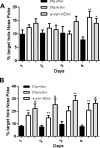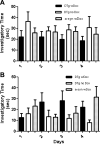Inducible dopaminergic glutathione depletion in an α-synuclein transgenic mouse model results in age-related olfactory dysfunction
- PMID: 21055449
- PMCID: PMC3010458
- DOI: 10.1016/j.neuroscience.2010.10.072
Inducible dopaminergic glutathione depletion in an α-synuclein transgenic mouse model results in age-related olfactory dysfunction
Abstract
Parkinson's disease (PD) involves both motor and non-motor disturbances. Non-motor features include alterations in sensory olfactory function which may constitute a viable biomarker for the disorder. It is not clear what causes olfactory dysfunction but it appears to coincide with the development of synucleopathy within the olfactory bulb (OB). Elevation in alpha-synuclein (a-syn) is indeed a risk factor for development of the sporadic disorder. The multifactorial nature of the idiopathic disease combined with variability in its presentation suggests that it is likely to be influenced by several factors and that in vivo models that explore the synergistic effect of alpha-synuclein elevation with other potential contributing factors are likely to be of importance in understanding the disease etiology. Using a dual transgenic (DTg) mouse model of dopaminergic alpha-synuclein overexpression coupled with doxycycline (Dox)-inducible glutathione (GSH) depletion in these same cells, we demonstrate an age-related loss in behavioral olfactory function coupled with a significant neurodegeneration of glomerular dopaminergic neurons. This is accompanied by increase in alpha-synuclein levels in non-dopaminergic cells in the granule cell layer (GCL). In addition, isolated olfactory bulb synaptosomes from dual transgenic lines with Dox consistently showed a slight but significant reduction in maximum mitochondrial respiration compared to controls. These results suggest that in the presence of increased oxidative stress, increased alpha-synuclein expression within dopaminergic OB neurons results in neurodegeneration in the glomerular layer (GL) and increased alpha-synuclein levels in the granular cell layer which coincide with olfactory dysfunction.
Copyright © 2011 IBRO. Published by Elsevier Ltd. All rights reserved.
Figures






Similar articles
-
The temporal expression pattern of alpha-synuclein modulates olfactory neurogenesis in transgenic mice.PLoS One. 2015 May 11;10(5):e0126261. doi: 10.1371/journal.pone.0126261. eCollection 2015. PLoS One. 2015. PMID: 25961568 Free PMC article.
-
Olfactory deficit and gastrointestinal dysfunction precede motor abnormalities in alpha-Synuclein G51D knock-in mice.Proc Natl Acad Sci U S A. 2024 Sep 24;121(39):e2406479121. doi: 10.1073/pnas.2406479121. Epub 2024 Sep 16. Proc Natl Acad Sci U S A. 2024. PMID: 39284050 Free PMC article.
-
Olfactory neuron-specific expression of A30P α-synuclein exacerbates dopamine deficiency and hyperactivity in a novel conditional model of early Parkinson's disease stages.Neurobiol Dis. 2011 Nov;44(2):192-204. doi: 10.1016/j.nbd.2011.06.017. Epub 2011 Jul 5. Neurobiol Dis. 2011. PMID: 21767644
-
Olfaction in Parkinson's disease and related disorders.Neurobiol Dis. 2012 Jun;46(3):527-52. doi: 10.1016/j.nbd.2011.10.026. Epub 2011 Dec 20. Neurobiol Dis. 2012. PMID: 22192366 Free PMC article. Review.
-
Reprint of: revisiting oxidative stress and mitochondrial dysfunction in the pathogenesis of Parkinson disease-resemblance to the effect of amphetamine drugs of abuse.Free Radic Biol Med. 2013 Sep;62:186-201. doi: 10.1016/j.freeradbiomed.2013.05.042. Epub 2013 Jun 3. Free Radic Biol Med. 2013. PMID: 23743292 Review.
Cited by
-
Microglial activation and antioxidant responses induced by the Parkinson's disease protein α-synuclein.J Neuroimmune Pharmacol. 2013 Mar;8(1):94-117. doi: 10.1007/s11481-012-9401-0. Epub 2012 Oct 10. J Neuroimmune Pharmacol. 2013. PMID: 23054368 Free PMC article.
-
Olfaction in three genetic and two MPTP-induced Parkinson's disease mouse models.PLoS One. 2013 Oct 30;8(10):e77509. doi: 10.1371/journal.pone.0077509. eCollection 2013. PLoS One. 2013. PMID: 24204848 Free PMC article.
-
Olfactory assays for mouse models of neurodegenerative disease.J Vis Exp. 2014 Aug 25;(90):e51804. doi: 10.3791/51804. J Vis Exp. 2014. PMID: 25177842 Free PMC article.
-
Overexpression of alpha-synuclein at non-toxic levels increases dopaminergic cell death induced by copper exposure via modulation of protein degradation pathways.Neurobiol Dis. 2015 Sep;81:76-92. doi: 10.1016/j.nbd.2014.11.018. Epub 2014 Dec 8. Neurobiol Dis. 2015. PMID: 25497688 Free PMC article.
-
Recent advances in the pathology of prodromal non-motor symptoms olfactory deficit and depression in Parkinson's disease: clues to early diagnosis and effective treatment.Arch Pharm Res. 2021 Jun;44(6):588-604. doi: 10.1007/s12272-021-01337-3. Epub 2021 Jun 19. Arch Pharm Res. 2021. PMID: 34145553 Free PMC article. Review.
References
-
- Arnold SE, Smutzer GS, Trojanowski JQ, Moberg PJ. Cellular and molecular neuropathology of the olfactory epithelium and central olfactory pathways in Alzheimer's disease and schizophrenia. Ann N Y Acad Sci. 1998;30855:762–775. - PubMed
-
- Attems J, Lintner F, Jellinger KA. Olfactory involvement in aging and Alzheimer's disease: an autopsy study. J Alzheimers Dis. 2005;7(2):149–57. discussion 173-180. - PubMed
-
- Berendse HW, Booij J, Francot CM, Bergmans PL, Hijman R, Stoof JC, Wolters EC. Subclinical dopaminergic dysfunction in asymptomatic Parkinson's disease patients’ relatives with a decreased sense of smell. Ann Neurol. 2001;50(1):34–41. - PubMed
-
- Braak H, Del Tredici K, Rub U, de Vos RA, Jansen Steur EN, Braak E. Staging of brain pathology related to sporadic Parkinson's disease. Neurobiol Aging. 2003;24(2):197–211. - PubMed
Publication types
MeSH terms
Substances
Grants and funding
LinkOut - more resources
Full Text Sources
Medical
Molecular Biology Databases
Miscellaneous

